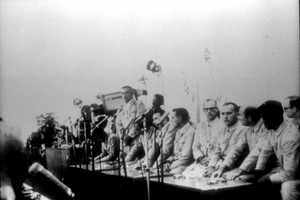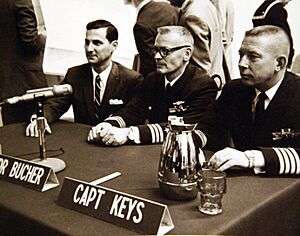Lloyd M. Bucher facts for kids
Quick facts for kids
Lloyd M. Bucher
|
|
|---|---|

Receiving the Purple Heart
|
|
| Nickname(s) | "Pete" |
| Born | September 1, 1927 Pocatello, Idaho, United States |
| Died | January 28, 2004 (aged 76) San Diego, California, United States |
| Place of burial |
Fort Rosecrans National Cemetery, San Diego, California
|
| Allegiance | United States of America |
| Service/ |
United States Navy |
| Rank | Commander |
| Commands held | USS Pueblo (AGER-2) |
| Battles/wars | World War II Cold War Korean DMZ Conflict Vietnam War |
| Awards | Purple Heart Prisoner of War Medal |
Lloyd Mark "Pete" Bucher (1 September 1927 – 28 January 2004) was an officer in the United States Navy. He is best known as the captain of the USS Pueblo. This ship was captured by North Korea on January 23, 1968.
Contents
Early Life and Education
Lloyd Bucher was born in Pocatello, Idaho. He had a tough start, being adopted and then losing his adoptive mother early. He lived with family members and in Catholic orphanages for a while.
In 1941, he found a new home at Boys Town in Boys Town, Nebraska. This was a special place for children in need. Lloyd loved it there and did very well in school and sports. He played football, basketball, track, and baseball.
Like many young men during World War II, he left high school early to join the United States Navy. He served from 1945 to 1947. During this time, he earned his high school diploma. Later, he went to the University of Nebraska on a football scholarship. He also joined the Naval ROTC program. In 1953, he graduated and became an officer in the Navy.
A Career Under the Sea
In 1954, Lloyd Bucher began his active duty in the Navy. He served on the USS Mount McKinley. In 1955, he went to submarine school in New London, Connecticut.
After finishing submarine school, Bucher served on several submarines. These included the USS Besugo and the USS Caiman. From 1961 to 1964, he was on the USS Ronquil. He worked his way up to executive officer, which is the second-in-command.
Lloyd Bucher really wanted to command his own submarine. However, most new submarines were powered by nuclear energy. He wasn't trained for nuclear submarines. So, he was chosen to command a different kind of ship. This ship was the USS Pueblo. It was a special ship used for collecting information and signals.
The Pueblo Incident
In January 1968, the USS Pueblo was watching North Korea. Suddenly, North Korean naval forces attacked it. These forces included submarine chasers and torpedo boats. The U.S. Navy and the crew said the ship was in international waters. This means it was not in North Korea's territory.
North Koreans attacked the ship, killing one crew member. They then took the ship and its 82 remaining crew members to a port in Wonsan. For the next 11 months, Captain Bucher and his crew were held as prisoners of war (POWs).
The crew later said they were treated very harshly and didn't get enough food. Their treatment got worse when the North Koreans realized the crew was secretly making a rude hand gesture in propaganda photos. The crew had tried to say it was a "Hawaiian good luck sign."
Captain Bucher faced difficult conditions. He was even put through a scary trick where it looked like he would be shot. This was to make him confess to spying. Finally, the North Koreans threatened to harm his men. Bucher agreed to write a confession to protect his crew. He wrote the confession himself. He included a secret joke, saying "We paean the North Korean state. We paean their great leader Kim Il Sung." This sounds like "we pee on" when spoken quickly.
After the U.S. gave an apology and promised not to spy again, North Korea released the crew. On December 23, 1968, the crew was taken to the border with South Korea. They walked across the "Bridge of No Return" to freedom. Captain Bucher led his men across the bridge. Exactly 11 months after being captured, they were free. The U.S. later said it didn't mean the apology or promises.
The USS Pueblo is still in North Korea. It is now a tourist attraction. The U.S. Navy still officially lists it as a commissioned ship.
After his release, the Navy held an investigation about Captain Bucher. Some people thought he should face a court martial (a military trial). However, the Secretary of the Navy, John H. Chafee, stepped in. He decided that no action would be taken against Bucher. Bucher had followed his orders not to start any international incidents. He believed that human lives were more important than a ship.
Captain Bucher was not found guilty of any wrongdoing. He continued his Navy career and retired with the rank of commander. In 1970, he wrote a book about the incident called Bucher: My Story.
In 1989, the U.S. government finally recognized the crew's bravery. They gave Prisoner of War Medals to all the crew members.
Later Life and Passing
Lloyd Bucher passed away on January 28, 2004. He was buried at Fort Rosecrans National Cemetery in San Diego, California. His funeral services were even shown on a TV show called Family Plots.
Awards and Recognition
Captain Bucher received several awards for his service. These included the Purple Heart and the Prisoner of War Medal.



